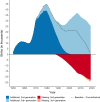The impact of early death on birth counts in the United States, 1950 to 2019
- PMID: 38854911
- PMCID: PMC11157966
- DOI: 10.1093/pnasnexus/pgae058
The impact of early death on birth counts in the United States, 1950 to 2019
Abstract
In a previous issue of PNAS Nexus, Bor et al. quantified the number of "missing Americans"-the deaths that would have been averted if the United States had experienced the mortality conditions of other wealthy nations. In 2019 alone, their estimates indicate that more than 100,000 individuals in reproductive ages (15-49 years) would have survived. The concept of the "missing Americans" is a valuable one, but here we argue that it is incomplete because it does not include children that would have been born to those who died an early death. We examine 3 indicators to assess the strength of the mortality-fertility nexus at the population level, showing that mortality more negatively affects birth counts in the United States than in other wealthy nations. Using the mortality conditions in other wealthy nations as a reference, we estimate that between 2010 and 2019 alone, approximately 200,000 children were not born in the United States due to the premature death of their potential mothers. Our findings highlight that improving morbidity and mortality among people of reproductive age-without compromising their reproductive autonomy-is critical in the United States.
Keywords: United States; counterfactual; demography; fertility; mortality.
© The Author(s) 2024. Published by Oxford University Press on behalf of National Academy of Sciences.
Figures




Similar articles
-
Missing Americans: Early death in the United States-1933-2021.PNAS Nexus. 2023 May 29;2(6):pgad173. doi: 10.1093/pnasnexus/pgad173. eCollection 2023 Jun. PNAS Nexus. 2023. PMID: 37303714 Free PMC article.
-
Assisted Reproductive Technology Surveillance — United States, 2012.MMWR Surveill Summ. 2015 Aug 14;64(6):1-29. MMWR Surveill Summ. 2015. PMID: 26270152
-
Assisted reproductive technology surveillance--United States, 2011.MMWR Surveill Summ. 2014 Nov 21;63(10):1-28. MMWR Surveill Summ. 2014. PMID: 25412164
-
The Minderoo-Monaco Commission on Plastics and Human Health.Ann Glob Health. 2023 Mar 21;89(1):23. doi: 10.5334/aogh.4056. eCollection 2023. Ann Glob Health. 2023. PMID: 36969097 Free PMC article. Review.
-
Exploring the association between short/long preceding birth intervals and child mortality: using reference birth interval children of the same mother as comparison.BMC Public Health. 2013;13 Suppl 3(Suppl 3):S6. doi: 10.1186/1471-2458-13-S3-S6. Epub 2013 Sep 17. BMC Public Health. 2013. PMID: 24564713 Free PMC article. Review.
References
-
- Sen A. 1990. More than 100 million women are missing. Vol. 37. New York: The New York Review of Books. p. 61–66.
-
- Bongaarts J, Guilmoto CZ. 2015. How many more missing women? Excess female mortality and prenatal sex selection, 1970–2050. Popul Dev Rev. 41:241–269.
LinkOut - more resources
Full Text Sources
Research Materials

